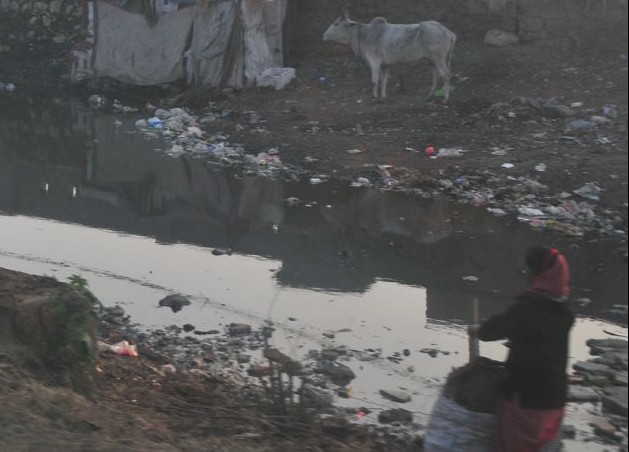Nearly one-third of India’s rapidly growing population now lives in towns and cities, with an estimated 14 million people residing in informal clusters, slums, urban and rural villages, and unauthorized colonies. Urban water supply for this population suffers from a growing supply-demand gap, inadequate levels of service and sporadic water supply, which is only exacerbated by highly variable seasonal and year-to-year rainfall.

If planned and managed correctly, proper water storage can mitigate this gap while increasing security, agricultural productivity and adaptive capacity. At the same time, however, improper open-air storage can present a significant health risk by providing breeding sites for mosquitoes.
Two mosquito-borne diseases are responsible for significant morbidity and health risk in India: malaria and dengue. The primary species that transmit these pathogens, Anopheles stephensi, Aedes aegypti and Aedes albopictus, readily exploit open water storage containers as larval habitats. India’s National Vector Borne Disease Control Programme reports approximately 1.5-2.0 million malaria cases and 1000 malarial deaths per year with Delhi listed as a “high risk region” for urban malaria. Meanwhile, reported dengue cases and deaths in India showed a three-fold increase from 2004 to 2005, most of which occurred in Delhi and surrounding regions. In 2010 there was a major dengue outbreak in Delhi in just as the city was preparing to host the Commonwealth games.
The Columbia Water Center Water Storage and Disease Risk Initiative seeks to better understand how select patterns of urbanization and climate variation modify the impact of human water storage practices on dengue and malaria in a setting such as Delhi.
Unlike in Africa where the malaria vector exploits small pools and puddles, this study will investigate the exploitation of artificial habitats by malaria and dengue vectors in India’s rapidly expanding built environment. This pilot study will provide the motivation for a future larger study across several cities aimed at determining how the climate and non-climate mechanisms driving vector proliferation and vector-borne disease transmission vary across India.
Question explored include: (i) How do demographic changes in an urban setting affect disease onset timing and transmission rates? (ii) How does storage capacity evolve and vary across the gradient of population density and income in the chosen sites? (iii) How does disease onset and transmission vary with climate and storage capacity at different spatial scales? (iv) What are the nascent patterns of urban area growth associated with specific types of water storage development? (v) Can we incorporate these interactions into disease mapping, risk prediction and response models?
Cross-cutting themes addressed include the interaction between climate and society, managing water scarcity, the role of public health and health delivery systems the nature and effect of urbanization as well as approaches to hazards and risk reduction that can lay the groundwork for the implementation of a climate-water-health risk management strategy in the region.
The ultimate goal is to enable countrywide monitoring and prediction of vector-borne disease risk in which local infrastructure, human activities and behavior, and disease incidence are robustly linked with local weather and large-scale climate variability. This will likely incorporate a variety of local and large-scale processes and tools, including demographic surveys, satellite measures, and biological and physical models.
Approach
To address the objectives outlined above, the project will carry out exploratory field studies and meetings with local partners to define, obtain, and analyze available data. Additional data will be obtained by surveying residents in case study sites within Delhi where people have been reported to be vulnerable to malaria and dengue. These surveys will include direct observation of housing structures and living conditions based on housing density with representative urban, peri-urban, and rural environments. Other data collection will include inspection of the physical characteristics of vessels and identification of mosquito species through larval and pupal sampling.
Using information gathered, the project will define and spatially map baseline information characterizing the urban, peri-urban and rural areas and assess the role of living conditions, human behavior and infrastructure as determinants of malaria and dengue transmission in the identified study sites with a goal of evaluating the role of storage and water supply infrastructure as a driver of disease incidence across the selected urban gradients. The project will then analyze the linkages between climate variability, municipal water supply timing and quantity, patterns of household access to water and storage, and disease outbreaks.
Finally, using the above information, the project will quantify how local changes in weather conditions affect disease incidence and prevalence across time scales (e.g. daily, weekly, seasonal, annual). In particular, we will examine how rainfall amounts and intensity can produce larval ejection and mortality; how rainfall frequency can optimize mosquito biting and ovipositing rates (Shaman and Day, 2007); and how humidity and temperature are associated with disease incidence, storage water levels, and larval abundance. Using data for disease incidence and climate, we will explore links between malaria and dengue outbreak timing and large-scale climate factors (e.g. monsoon onset and breaks), urbanization, and storage practices.
